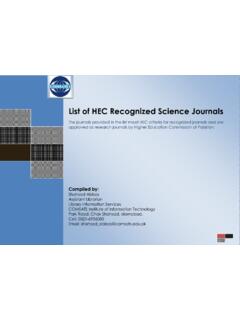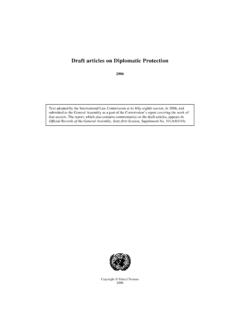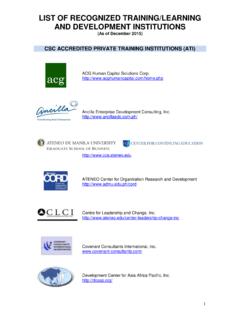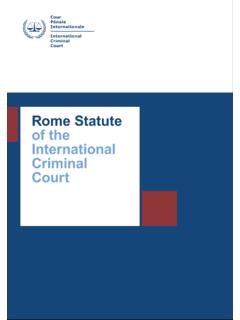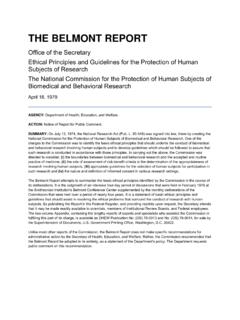Transcription of Fact Sheet No.21, The Human Right to Adequate Housing
1 Fact Sheet , The Human Right to Adequate Housing Contents: Introduction Clarifying governmental obligations The obligations of the international community The entitlements of Housing rights Monitoring the Right to Adequate Housing Towards the justiciability of Housing rights Annexes: I. Legal sources of the Right to Adequate Housing under international Human rights law II. Revised guidelines regarding the form and contents of States reports to be submitted by States parties under Articles 16 and 17 of the Covenant on Economic, Social and Cultural Rights III. General Comment on the Right to Adequate Housing IV.
2 Non-governmental organizations working for Housing rights V. Select bibliography and further reading Introduction The International Bill of Rights At the core of United Nations action to protect and promote Human rights and fundamental freedoms is the International Bill of Rights. The Bill consists of three instruments: The Universal Declaration of Human Rights (1948);. The International Covenant on Economic, Social and Cultural Rights (1966);. The International Covenant on Civil and Political Rights (1966). These three documents define and establish Human rights and fundamental freedoms. They form the foundation for the more than 50 additional United Nations Human rights conventions, declarations, sets of rules and principles.
3 The Covenants are international legal instruments. This means that members of the United Nations, when they become parties to a Covenant or other conventions by ratifying or acceding to them, accept major obligations grounded in law. States parties voluntarily bind themselves to bring national legislation, policy and practice into line with their existing international legal obligations. By ratifying these and other binding texts, States become accountable to their citizens, other States parties to the same instrument and to the international community at large by solemnly committing themselves to respect and ensure the rights and freedoms found in these documents.
4 Many of the major international Human rights treaties also require States parties to report regularly on the steps they have taken to guarantee the realization of these rights, as well as on the progress they have made towards this end. This Fact Sheet addresses the foundations, implications and content of one particular Right found in many international legal texts, including the Covenant on Economic, Social and Cultural Rights and the Universal Declaration: the Human Right to Adequate Housing . A series of important developments concerning this Right have taken place during the past several years within various United Nations Human rights bodies.
5 These and other issues will be outlined below. Achieving economic, social and cultural rights Despite the fact that there are two Covenants, each guaranteeing a separate set of Human rights, the interdependence and indivisibility of all rights are a long-accepted and consistently reaffirmed principle. In reality, this means that respect for civil and political rights cannot be separated from the enjoyment of economic, social and cultural rights and, on the other hand, that genuine economic and social development requires the political and civil freedoms to participate in this process. It is these underlying principles, of interdependence and indivisibility, which guide the vision of Human rights and fundamental freedoms advocated by the United Nations.
6 Nevertheless, the mutually reinforcing nature of Human rights implying that all Human rights should be treated equally under law and in fact-has proven difficult to translate into practice. While the implementation of all Human rights is problematic, the difficulties encountered in realizing economic, social and cultural rights have proved particularly intractable. In response to these challenges and in recognition of the direct link between Human rights and development, the United Nations is paying an increasing degree of attention to economic, social and cultural rights and to ways in which the international community can work together to ensure their realization.
7 A number of specific steps towards the effective implementation of economic, social and cultural rights have been taken by various United Nations Human rights bodies in recent years. These include the establishment in 1987 of the Committee on Economic, Social and Cultural Rights (see Fact Sheet No. 16); the appointment by the Sub-Commission on Prevention of Discrimination and Protection of Minorities of Special Rapporteurs on issues such as the Right to food, the realization of economic, social and cultural rights, extreme poverty and promoting the realization of the Right to Adequate Housing . Human rights permeate all areas of United Nations activity and several of the specialized agencies, such as the International Labour Organisation (ILO) and the United Nations Educational, Scientific and Cultural Organization (UNESCO), have maintained Human rights portfolios for decades.
8 An increasing number of additional United Nations agencies have begun incorporating Human rights concerns into their respective programmes of work. This is particularly true of the United Nations Children's Fund (UNICEF), the United Nations Development Programme (UNDP) and the World Health Organization (WHO). Each of the above-mentioned developments have facilitated and strengthened United Nations attention to these rights. The Right to Adequate Housing is one of the economic, social and cultural rights to have gained increasing attention and promotion, not only from the Human rights bodies but also from the United Nations Centre for Human Settlements (Habitat).
9 This began with the implementation of the Vancouver Declaration on Human Settlements issued in 1976, followed by the proclamation of the International Year of Shelter for the Homeless (1987) and the adoption of the Global Strategy for Shelter to the Year 2000, by the United Nations General Assembly in 1988. What does Housing have to do with Human rights? At first glance, it might seem unusual that a subject such as Housing would constitute an issue of Human rights. However, a closer look at international and national laws, as well as at the significance of a secure place to live for Human dignity, physical and mental health and overall quality of life, begins to reveal some of the Human rights implications of Housing .
10 Adequate Housing is universally viewed as one of the most basic Human needs. Yet as important as Adequate Housing is to everyone, the United Nations Centre for Human Settlements estimates that throughout the world over 1 billion people live in inadequate Housing , with in excess of 100. million people living in conditions classified as homelessness. Access to drinking water and Adequate sanitation facilities are additional basic needs directly associated with Housing . According to figures released by the World Health Organization, billion people in developing countries do not have access to drinking water and billion people live without access to Adequate sanitation (WHO Decade Assessment Report, 1990).










